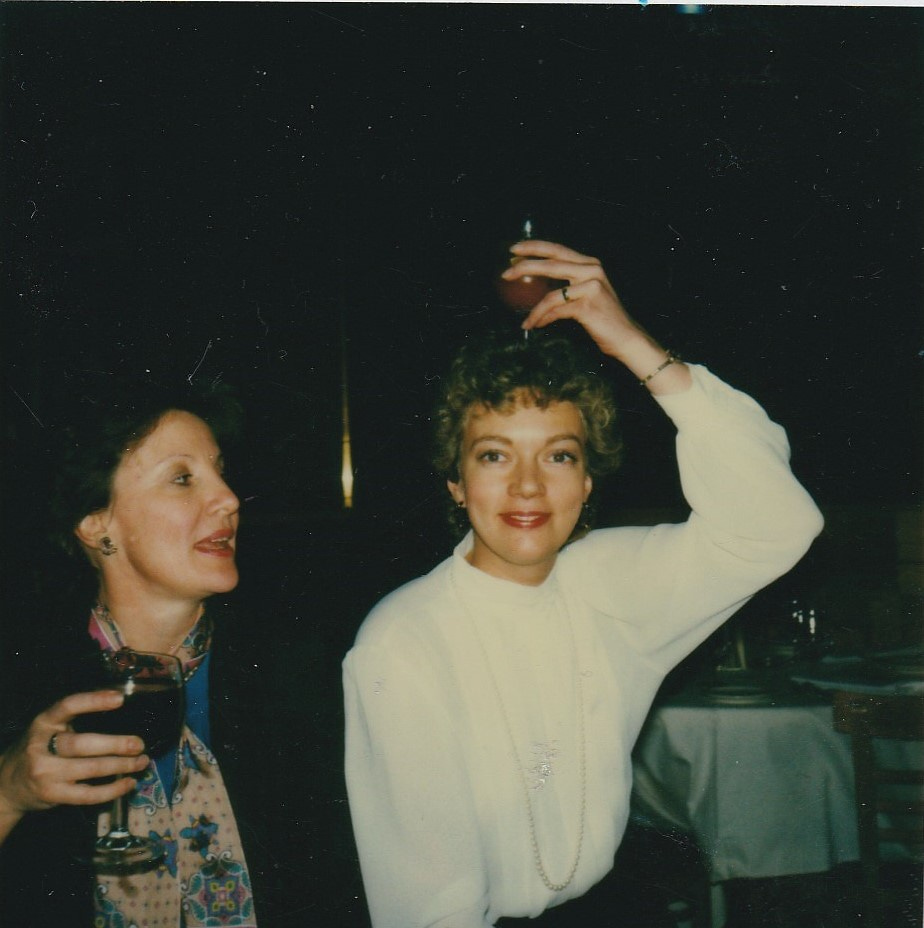For the first few months I worked at Savvy, I lived in my parents’ guest room, in their apartment on West 93rd Street, not the run-down classic six they occupied during my high school and college years, but a co-op in a better maintained building. Still, many of the old accoutrements of my childhood remained: the bedspreads, the desk, paintings from my college forays into the fine arts. Did it feel weird living at home? I don’t think so. It was rather comforting to be surrounded by my old books, back with Mother and Dad, who had their own routines and would in a few years retire to Florida.
Weekends I took the train out to Montauk to be with Mr. Landi and the cats. He was working on another book proposal, seemingly content with the isolation of the East End in winter. If ever there was an opportunity for a young and fragile marriage to fall apart, this was it. And I’ve wondered in retrospect if this would not have been a good time to say “Sayonara, so long, buddy. I’m gainfully employed and striking out on my own.” But that did not happen. Love may fly out the window when poverty enters the door, but we were too much a part of each other’s emotional furniture to dismantle the floor plan.
Eventually, through my mother’s connections at her school, we moved into a two-bedroom rent-controlled apartment on West 92nd Street, in the block directly behind my parents. Freakishly and uncomfortably close, but beggars, etc. It was a miserable roach-infested hovel that could have been quite nice (I remember herringbone parquet floors, paint-encrusted moldings, a fireplace), but we didn’t have the money, and as illegal subletters could not even complain to the landlord about the heat or the vermin. That spring and summer we would set off roach bombs in the kitchen, and then pack up the cats and head out to the Montauk house on weekends (did we take them on the train? could we afford rental cars? I now can’t remember). When we returned on Sunday nights, the floor would be littered with tiny glossy bug carcasses.
Into this particular circle of hell (the one for people who want to live in Manhattan but can’t afford the rents in a marginally decent neighborhood) came Martha Stewart. We got many free books from publicists at the office—self-help, cookbooks, style guides, and so on, though I don’t recall that we ever ran book reviews. One of these titles was Martha’s very first, Entertaining (1982, revised a few decades later), with the young style icon and future convict posing at the head of a gloriously sunstruck table, set with gleaming china and crystal, presided over by graceful summer posies. I leafed through this volume as though it were holy writ, imagining a world where people ate peach tarts and oysters on the half shell from a porch overlooking the Long Island Sound, turning ruffled pillowcases into tablecloths. And it occurred to me later that Martha was poised on the brink of staggering success, preaching the gospel of rarefied domesticity, at the very moment when hundreds of thousands, if not millions, of women were spending most of their days in the workplace.
At my workplace, the premises seemed always to roil with low-level drama, a situation Wendy encouraged and even enjoyed, management by hysteria. Anyone who has ever worked in an office knows how easily they can turn into snake pits. In my very first job, in the production department of the one of the divisions of Macmillan Publishing, I once encountered the art director, after hours, riffling through my boss’s wastebasket. What was he looking for? What did he hope to learn? I didn’t ask, and he simply slunk away in embarrassment. On the day that management announced it had to terminate a third of the department, reps from human resources went from one office to the next, giving the bad news. People were packing up and leaving in tears. At 23, I could not understand the tragedy of losing a job in what seemed to me a very dull business.
When Wendy hired Nancy Smith to be executive editor of Savvy, we on the lower rungs of the masthead hoped for a new level of professionalism sorely lacking in the loyal but untutored troops. She came from Texas Monthly, a hugely respected prize-winning publication headquartered in Austin. Nancy had worked with writers then considered hot properties in the magazine business, like Bill Broyles and Robert Sam Anson (described in his Times obit three years ago as “a master of the vividly reported, sharply etched long-form magazine piece”). It was to Anson that she gave one of her first big assignments, a report on the romance between William Agee, the charismatic young CEO of Bendix Corporation, and his executive assistant, Mary Cunningham. It’s hard to understand today what the big flap was all about, but contemporary accounts focused on the dangers of romance-fueled favoritism (like, duh, this hadn’t been going on for centuries?). It was not about sexual harassment at all. Nonetheless Cunningham’s fast rise within the company fueled all sorts of business-page outrage. Whether Anson’s cover story made a dent in our fledgling magazine’s credibility or in the annals of relations between the sexes is hard to say. For sure it established Nancy as the star of Savvy, as she stayed in the office late, hunched over the manuscript, conferring with Anson by phone, rushing the thing into print.
For those not familiar with how a magazine operates—or used to operate—let me offer a précis here. Generally the senior staff meets to bounce around ideas, determine new directions, give progress reports. These must have been fairly democratic at Savvy since I, the lowly copy editor and fact checker, was included. At other magazines, the assigning function may fall to a smaller group (at ARTnews, the editor-in-chief and executive editor made the bulk of the decisions, with senior editors occasionally contributing ideas). Once a manuscript arrives in the office, it’s eyeballed by the higher-ups and perhaps sent back for revisions. (Wendy Crisp once memorably announced, “We’re going to make them rewrite five, six times until they finally get it right!” as though writers were hopeless miscreants whose behavior could only be fixed by repeated corrections—“the beatings will continue until morale improves!” Trust me, most journalism doesn’t work this way, and no writer I know has the energy to go through five or six rounds of revisions.)

The manuscript, in whatever shape it arrives, might be sent to the art department, who will determine a layout and photos or illustrations, even as the assigning or line editor is massaging the piece into print-ready form. One of the final stops before moving onto page proofs was me, for fine tuning the grammar and imposing house style. And it was in this function that one of my more memorable flare-ups with Nancy Smith occurred. Nancy had commissioned a humor piece from Roy Blount Jr., the author of 24 books but possibly best known for his guest appearances on NPR’s “Wait, Wait, Don’t Tell Me.” I forget what he turned in for Savvy, but Ms. Smith approached me in a fury with the galleys in hand, demanding to know what happened to the commas around the “Jr” in his name. I calmly said I’d decided to get rid of restrictive commas around “junior” and “senior.” They’re simply not necessary, I explained. She tapped the page on my desk emphatically, “Read my lips. The man’s name is Roy Blount, comma, Junior, comma!”
“That’s no longer our house style,” I politely averred. “And I am the one who determines house style.”
I believe I won that battle, but it was a small victory as the office increasingly began to resemble a war zone with Nancy infiltrating every aspect of the magazine except perhaps ad sales, setting herself up as de facto editor-in-chief whose decisions and approval carried the day. Things got so bad that our real editor-in-chief, Wendy Reid Crisp, retreated to her house in Pound Ridge and stayed there for a month. And this is when I found myself in the odd position of go-between, an uncomfortable pickle but unexpectedly also the key to professional advancement.
Stuffed Jalapenos
I no longer own Martha Stewart’s Entertaining, but I went online recently in search of a recipe that might duplicate a friend’s stuffed jalapenos, and here’s what I found. I haven’t made it yet because I’ve been too wiped out to cook. But I will give it a try shortly.
Ingredients
4 ounces cream cheese, room temperature
½ cup grated sharp cheddar
6 large jalapenos, halved and seeded
Coarse salt and ground pepper
Directions
Preheat oven to 450 degrees. In a small bowl, mix together cream cheese and cheddar. Season with salt and pepper. With a small spoon, fill each jalapeno half with about 1 tablespoon cheese mixture. Place peppers on a parchment-lined baking sheet and bake until cheese is browned and bubbling, about 10 minutes, rotating sheet halfway through.
Notes: Some recipes advise wearing disposable gloves when working with jalapenos, or coating your hands with cooking oil to protect your skin. Whatever you do, wash your hands thoroughly and don’t touch your eyes for several hours after working with peppers!
There are of course an infinite number of variations on this recipe: add bacon bits, crumbled sausage, and/or or finely minced garlic. Try jack cheese instead of cheddar. Sprinkle with smoked paprika. Etc., etc.





Love love love (no commas) your response to Nancy! ❤️❤️❤️
One of my favorite vignettes yet! Thank you for all of your efforts in retelling past excerpts of your life.